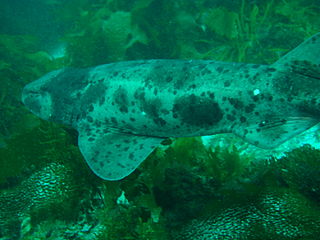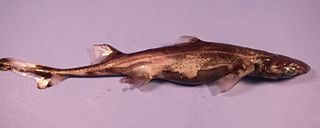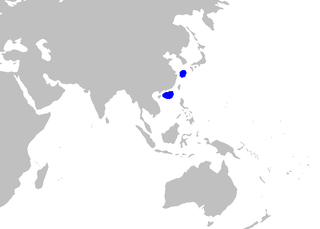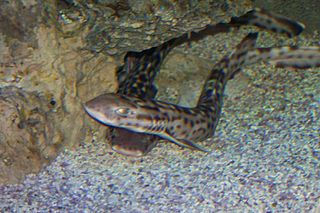
Carcharhiniformes, the ground sharks, are the largest order of sharks, with over 270 species. They include a number of common types, such as catsharks, swellsharks, and requiem sharks.

The guitarfish, also referred to as shovelnose rays, are a family, Rhinobatidae, of rays. The guitarfish are known for an elongated body with a flattened head and trunk and small, ray-like wings. The combined range of the various species is tropical, subtropical, and warm temperate waters worldwide.

Apristurus is a genus of catsharks, the family Pentanchidae, the deepwater catsharks. The species in this genus are commonly known as the ghost or demon catsharks.

Cephaloscyllium is a genus of catsharks, and part of the family Scyliorhinidae, commonly known as swellsharks because of their ability to inflate their bodies with water or air as a defense against predators. These sluggish, bottom-dwelling sharks are found widely in the tropical and temperate coastal waters of the Indian and Pacific Oceans. They have stocky, spindle-shaped bodies and short, broad, and flattened heads. The mouth is capacious, containing many small teeth and lacking furrows at the corners. The two dorsal fins are placed far back on the body, with the first much larger than the second. Different species have various color patterns of saddles, blotches, reticulations, and/or spots. The largest members of the genus can grow over 1 m (3.3 ft) in length. Swellsharks prey on a variety of fishes and invertebrates, and are oviparous, with females producing egg capsules in pairs. They are harmless and have been deemed of having no commercial value.

Parmaturus is a genus of deepwater catsharks in the family Pentanchidae. Four species were described in 2007 and another in 2019 with more species likely to be described in the near future.

Galeus is a genus of deepwater catshark, belonging to the family Pentanchidae, commonly known as sawtail catsharks in reference to a distinctive saw-toothed crest of enlarged dermal denticles, found along the upper edges of their caudal fins. They are found in the Atlantic, the western and central Pacific, and the Gulf of California, inhabiting deep waters at or close to the sea floor. Members of this genus are rather small, slim sharks with firm bodies and thick, rough skin. Their heads are usually fairly long and pointed, and have large mouths with well-developed furrows at the corners. They have large pectoral and anal fins, and two similar dorsal fins placed well back. Many species are ornately patterned with dark saddles and/or blotches. Sawtail catsharks feed on various invertebrates and fishes, and may be either egg-laying or live-bearing. These harmless sharks are sometimes caught as bycatch but are of minimal commercial value.

Etmopterus is a genus of lantern sharks in the squaliform family Etmopteridae. They are found in deep sea ecosystems of the Atlantic, Indian and Pacific Oceans.

The blackgill catshark or blackgill bristle shark is a deep water bristle shark known from very few specimens, found on or near the bottom on the continental slope, at 540–835 metres (1,772–2,740 ft) off the coasts of China and Japan. Specimens can attain a total length of at least 85 cm (33 in), have elongated cat-like eyes, and have two small dorsal fins set far back. They’re oviparous and lay one egg at a time. This shark is a potential bycatch of deep water bottom-trawl fisheries operating within its range, but no specific information is available. In the upper jaw, there are rods of blunt, flat teeth with 3 cusps, likely used for crushing, as well as row of sharper teeth with the mid, central cusp longer and to a point. The bottom teeth are sharp, pointed, jagged and have three cusps, with the middle cusp slightly longer than the surrounding two.

The narrowmouthed catshark is a coloured catshark beloning to the family Atelomycteridae, found from central Chile around the Straits of Magellan, to Argentina between latitudes 23° S and 56° S, at depths down to about 180 m (600 ft) in the Atlantic Ocean and about 360 m (1,200 ft) in the Pacific. It can grow to a length of up to 70 cm (28 in). The reproduction of this catshark is oviparous.

The beige catshark, or beige bristle shark, is a bristle shark of the family Dichichthyidae, The first recorded specimen was a female recorded off the coast of Queensland, Australia around Lord Howe Island. Its length was 72 cm.
Bythaelurus is a genus of sharks belonging to the family Pentanchidae, the deepwater catsharks. The genus Bythaelurus Compagno 1988 was first described as a subgenus of Halaelurus Gill 1862 based on several morphological characteristics including a soft body with thin skin, a bluntly rounded snout without a pointed, knob-like tip, and eyes not noticeably elevated on the dorsal surface of the head. Members of this genus are generally found in deep water and have more somber body coloration.

The white-tip catshark or white-tip bristle shark is a recently described, deepwater bristle shark, known only from a single specimen collected from northern New Caledonia, at a depth of 590–732 m. The only known specimen, an adult male, measured a total of 57.7 cm in length. These sharks have spiracles, which are respiratory openings behind the eyes. They are also recognized by two little dorsal fins. Numerous individuals from this group of sharks are likewise called dogfish.
The phallic catshark is a species of shark belonging to the family Pentanchidae, the deepwater catsharks. It is found on or near the ocean floor, in the deep waters off New Caledonia and Vanuatu. A slender species attaining a length of 46 cm (18 in), it is characterized by a long caudal fin bearing a crest of enlarged dermal denticles along the dorsal margin, and very long claspers in adult males. This shark is gray-colored, with four dark saddles along the back and tail.
The starry catshark is a species of shark belonging to the family Pentanchidae, the deepwater catsharks. This species is found in New Caledonia.
The false shark ray is a species of fish in the Rhinidae family and the only species in the genus Rhynchorhina. This rare ray is only known from shallow coastal Atlantic waters in Banc d’Arguin, Mauritania.
The roughback bristle shark is a species of bristle shark of the newly discovered Dichichthyidae family, and was discovered in 2024. The species can reach a length of 1.05 m. The roughback bristle shark lives off the waters of New Zealand, at a depth of between 2,200 and 3,900 ft.

Atelomycteridae, the coloured catsharks, is a family of sharks belonging to the order Carcharhiniformes. These sharks are found in the Indian, Pacific and Western Atlantic Oceans.
The Indonesian filetail catshark is a species of shark belonging to the genus Dichichthys, the bristle sharks. This shark was first described as Parmaturus nigripalatum in 2018 by Fahmi and Ebert with its type locality given as south of Sumbawa at 9.04°S, 117.92°E from a depth of 170–190 m (560–620 ft). It is known from three specimens collected in the South China Sea.











